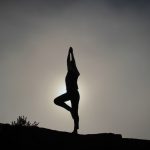Most people learn early in their yoga journey that pranayama, the fourth of the eight limbs of yoga, refers to breathing exercises. This definition works to begin with, but it is not the full story. Let’s unpack some key concepts to paint a more complete picture, shall we?
Let’s Start With The Breath
We are all kept alive by this process whereby oxygen is brought into our bodies, and carbon-dioxide is discharged from our bodies. We need oxygen to nourish our cells, and waste to be removed, otherwise we would not survive. Breath is a fascinating process, because our bodies do it for us automatically, yet we also have some ability to control it. This is where the breathing exercises come in: we can manipulate our breath towards certain objectives, such as for relaxation or for energising ourselves. Today, there is lots of scientific research available out there which establishes links between breath and well-being, as well as therapies based solely on the manipulation of breath.
Long ago, breath was considered an essential tool to help regulate prana. The yogis describe prana as the force which powers the universe. That’s a pretty big concept to take in, so I like to use this analogy: let’s say your body is like a toaster, and prana is the electricity which powers it. As we all know, if you don’t have electricity the toaster doesn’t work. Similarly, if the electric circuits aren’t working, the toaster may blow up, or just stop working.
How exactly does this link to the breath? Well, the yogis explain that controlling the breath is one of the ways can become aware of the subtle force of prana. Then through regular practice of breathing and established awareness, we can clear blocks in the flow of prana, and eventually we can begin to exert some control over it.
The Practice Of Panayama
The suffix -ayama here means restraint or control. Therefore, pranayama refers to the control of this subtle energy, through the means of the breath. The Sutras refer to three aspects of breath we can control: inhalation, exhalation and retention. We can vary these aspects by varying place (where we place our attention), time (which we inhale, exhale or hold the breath) and count (how many times we do it).
In addition, we should practice pranayama in an appropriate asana, a steady and comfortable posture, which will allow us to get the full benefit of practice. Many typical yoga classes incorporate one or two forms of pranayama, either as a discreet exercise at the end of a class, or as part of the asana practice.
The great teachers of yoga acknowledge that this is a difficult practice which takes time, and they say that no amount of learning about prana will help you understand it fully. Practising with instruction from a teacher is essential.
The Theory Behind It All
If you remember my first article about the eight limbs of yoga, and why we needed to pay attention to these, the reason was that perfecting the eight limbs would help us to calm the mind. This in turn helps us to stop identifying with the ‘monkey-mind’. According to Sri Satchidananda in his commentary on The Yoga Sutras of Patañjali, pranayama is key in helping us with this calming of the mind:
By regulating the prana, we regulate our minds, because the two always go together. If one is controlled, the other is automatically controlled as well.
In addition to this, we can link our practice of pranayama to a type of tapas, a purifying of the body and mind, like we mentioned when looking at the yamas and niyamas. To go back to our toaster analogy, we do it so that the electricity can flow efficiently and smoothly, without short-circuits in our energy system!
Variations On A Theme
You may encounter pranayama in many forms, which all have different effects. Among other effects, they may be energising, calming, cleansing or purifying. Here are a few examples:
- Ujjayi breath – this is an intrinsic part of the Ashtanga yoga practice. Inhalation and exhalation is long and deep, and because it is practised with the throat slightly contracted, it sounds like a soft snore.
- Alternate Nostril Breathing – this is usually practised at the end of the class, by inhaling through one nostril and exhaling through the other, and helped by blocking alternate nostrils.
- Kapalabhati breathing – another end-of-class exercise, Kapalabhati breathing is practised by pushing air out through a forceful contraction of the abdominal muscles.
There are many others, including lion’s breath, cooling breath or humming breath, which are all quite commonly taught in regular yoga classes. It’s important to mention that you should work with a trained teacher when learning new types of breath work.
The Silken Thread
Swami Vivekananda makes a beautiful analogy in Raja Yoga and Patañjali Sutra as follows:
In this body of ours the breath motion is the ‘silken thread’; by laying hold of and learning to control it, we grasp the pack of nerve currents, and from these the stout twine of our thoughts, and lastly the rope of Prana, controlling which we reach freedom.
Experience the power of the breath for yourself – how about becoming aware of your breath throughout the day? Notice how it may be subtly different at times, or in certain moods, and see if you can change your mood by changing your breath.













